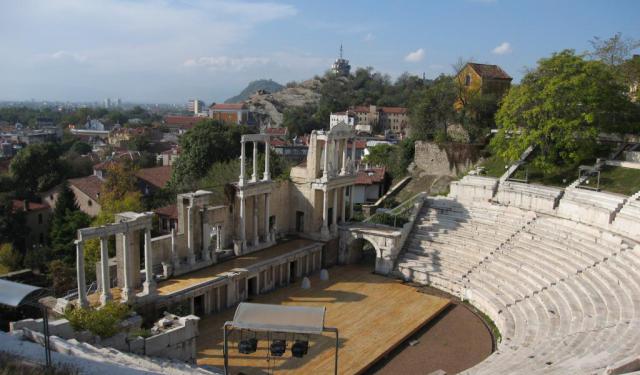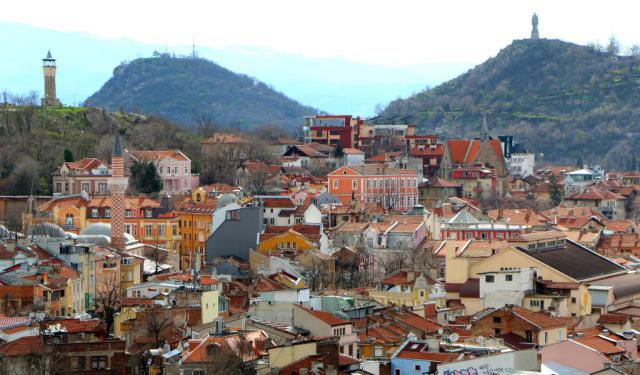Domus Eirene (House of Eirene), Plovdiv
The House of Eirene is an ancient Roman peristyle house. The construction of this house likely followed the devastating Siege of Philippoupolis by the Goths in 250 AD, a tumultuous period known as the Crisis of the Third Century in the Roman Empire. The name "Eirene" is derived from the central mosaic within the house, which portrays the graceful figure of the Greek goddess Eirene, symbolizing peace and tranquility.
The archaeological discovery of this late antique building, along with segments of two Roman streets forming a crossroads, was made possible through the dedicated efforts of archaeologists Zdravko Karov and Mina Bospachieva during excavations in 1983-1984.
The architectural features of the "Eirene" building are notable, with a distinctive entrance leading to a vestibule that grants access to the southern portico within an open courtyard. This portico serves as a link between the more formal sections of the house and the residential areas, connecting the courtyard with surrounding spaces such as the banquet hall (triclinium) and the reception room (tablinum) where the owner would welcome visitors.
The true treasures of the "Eirene" building lie underfoot, as the floors of its various rooms are adorned with polychrome mosaics showcasing intricate geometric patterns and figures. Initially, mosaics graced only the southern portico and the banquet hall, with a particularly remarkable mosaic depicting a woman accompanied by an ancient Greek inscription. Subsequently, mosaics were also laid in the vestibule, the eastern portico (over the marble slab pavement), the northern room, and the reception room, including its added apse.
Following the conclusion of excavations in the area, a concerted effort was made to preserve these archaeological structures in their original location. The formal sections of the "Eirene" domus were separated and transformed into an exhibition hall, allowing for the preservation and public display of these captivating finds. Today, visitors have the opportunity to admire the beautifully restored mosaics in their original setting at the Trakart Cultural Center.
The archaeological discovery of this late antique building, along with segments of two Roman streets forming a crossroads, was made possible through the dedicated efforts of archaeologists Zdravko Karov and Mina Bospachieva during excavations in 1983-1984.
The architectural features of the "Eirene" building are notable, with a distinctive entrance leading to a vestibule that grants access to the southern portico within an open courtyard. This portico serves as a link between the more formal sections of the house and the residential areas, connecting the courtyard with surrounding spaces such as the banquet hall (triclinium) and the reception room (tablinum) where the owner would welcome visitors.
The true treasures of the "Eirene" building lie underfoot, as the floors of its various rooms are adorned with polychrome mosaics showcasing intricate geometric patterns and figures. Initially, mosaics graced only the southern portico and the banquet hall, with a particularly remarkable mosaic depicting a woman accompanied by an ancient Greek inscription. Subsequently, mosaics were also laid in the vestibule, the eastern portico (over the marble slab pavement), the northern room, and the reception room, including its added apse.
Following the conclusion of excavations in the area, a concerted effort was made to preserve these archaeological structures in their original location. The formal sections of the "Eirene" domus were separated and transformed into an exhibition hall, allowing for the preservation and public display of these captivating finds. Today, visitors have the opportunity to admire the beautifully restored mosaics in their original setting at the Trakart Cultural Center.
Want to visit this sight? Check out these Self-Guided Walking Tours in Plovdiv. Alternatively, you can download the mobile app "GPSmyCity: Walks in 1K+ Cities" from Apple App Store or Google Play Store. The app turns your mobile device to a personal tour guide and it works offline, so no data plan is needed when traveling abroad.
Domus Eirene (House of Eirene) on Map
Sight Name: Domus Eirene (House of Eirene)
Sight Location: Plovdiv, Bulgaria (See walking tours in Plovdiv)
Sight Type: Attraction/Landmark
Guide(s) Containing This Sight:
Sight Location: Plovdiv, Bulgaria (See walking tours in Plovdiv)
Sight Type: Attraction/Landmark
Guide(s) Containing This Sight:
Walking Tours in Plovdiv, Bulgaria
Create Your Own Walk in Plovdiv
Creating your own self-guided walk in Plovdiv is easy and fun. Choose the city attractions that you want to see and a walk route map will be created just for you. You can even set your hotel as the start point of the walk.
Roman Ruins Walking Tour
If you’re a fan of Spartacus, a warrior turned slave and gladiator, who led an uprising against the Roman Empire in the 1st century BC, you probably remember him being called a “Thracian dog” by his enemies. Now, Thrace is the name of the region that encompasses present-day Bulgaria and the Western Part of Turkey. Plovdiv, once known as Philippopolis, is one of its most important cities.
... view more
Tour Duration: 2 Hour(s)
Travel Distance: 3.3 Km or 2.1 Miles
... view more
Tour Duration: 2 Hour(s)
Travel Distance: 3.3 Km or 2.1 Miles
Plovdiv Introduction Walking Tour
Plovdiv is Bulgaria’s second-largest city and one of the oldest continuously inhabited cities in Europe. Nicknamed "The City of the Seven Hills," it boasts over 8,000 years of history, with traces of habitation dating back to the 6th millennium BC. Straddling the Maritsa River in south-central Bulgaria, Plovdiv's thick cultural layers reveal influences from Thracians, Romans,... view more
Tour Duration: 2 Hour(s)
Travel Distance: 2.7 Km or 1.7 Miles
Tour Duration: 2 Hour(s)
Travel Distance: 2.7 Km or 1.7 Miles





